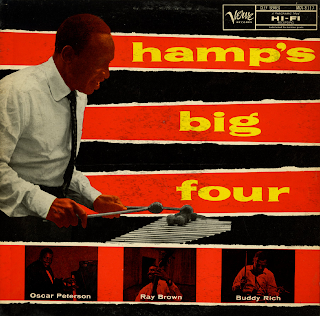Midnight Sun
Hamp's Big Four
Lionel Hampton
Cover Photo by Herman Leonard
Verve MGV-8117
1957
From the back cover: If, as has been stated by pointers with pride and viewers with alarm alike, the current trend in jazz is all to the gentle, delicate type of chamber works, here is a quartet – namely Hamp's Big Four – which would stand resolutely, not to mention swingingly, on the opposite side of the fence. Hamp's Big Four includes, as in the past, Lionel Hampton at the vibraharp; Oscar Peterson on piano, Ray Brown at the bass and Buddy Rich on drums. Now if ever a jazz quartet was dedicated to delicacy this one most definitely is not it. The hallmark of this quartet of jazz stars, generally speaking, is strength, virility, high spirits. The hushed air is entirely lacking; in its place is a very contagious exuberance and an air of fun – in fact, these sides would appear to have more outright fun in them than any to come along in the jazz field for a long, long while. The most conspicuous example of this is to be found in the traditional "When The Saints Go Marching In," which gets anything but a traditional treatment here. This one has a vocal by someone not often given to singing – bassist Ray Brown. Probably the best way to describe Ray's singing is to say that he does it with an infectious abandon. He isn't alone, though, there's strong support from the other voices at hand, and to say these other voices "chime" in would be a rank understatement. There's also a pair of introductions – to solos by Oscar Peterson and Buddy Rich – that are fairly unusual on record. This spirit of high, good humor runs throughout the album, along with a perceptible undercurrent of excitement which hits its peak in "That Old Black Magic," played at a much faster tempo than customary. Hampton's "Blues For Norman" (Granz, of course) is a happy romp in which a number of familiar melodies – even including the briefest hint of "White Christman" – manage to sneak in. Rich contributes an effective drum solo near the finish. Another Hampton original, the very durable "Midnight Sun," finds him in more of a reflective mood than is usual. Hampton likewise state the melody of "It's A Blue world" with almost wistful sort of tenderness before Peterson's piano takes over in a more blue-ish vein, which Hampton thereupon maintains on his return to the soloist's spotlight.
In all, this is a particularly good example of muscular, blues-rooted, modern, swinging jazz marked with a fine interplay of talents. It is, clearly, an album that was fun to make; it is a consequence fun to hear.
That Old Black Magic
Blues For Norman
It's A Blue World
When The Saints Go Marching In
Midnight Sun

No comments:
Post a Comment
Howdy! Thanks for leaving your thoughts!